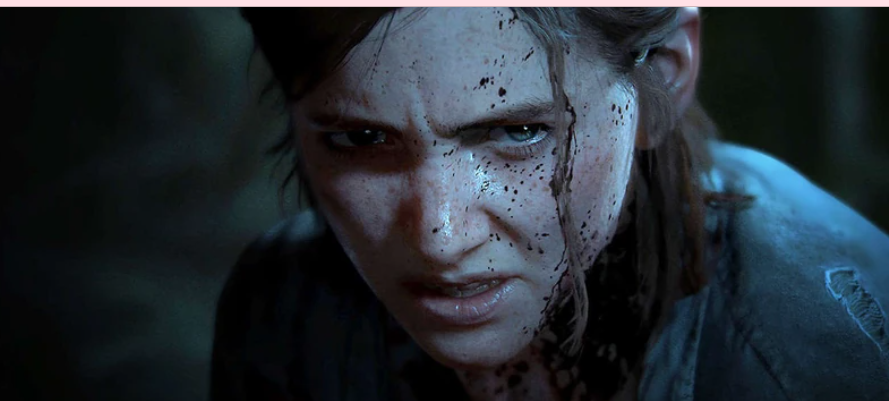
There aren’t many ways to broach the topic of The Last of Us Part II without inviting a deluge of criticisms from all sides.
I wouldn’t have expected the sequel to one of the most universally acclaimed games of the 2010s to be the one to generate the most vitriol and bad-faith critiques this side of Gamergate—but something tells me developer Naughty Dog wasn’t quite as surprised as I was when their sprawling sapphic revenge epic ended up pissing off the exact kind of people who get upset about any story that centers women, and queer women in particular. I don’t believe they set out with the goal of polarizing the “gaming community” (whatever that means anymore), but the possibility couldn’t have been totally off their radar knowing what story they were trying to tell.
In light of this, I think it’s important to mention upfront that if you’re one of the people who found a certain character’s death to be some kind of preachy political statement rather than a profoundly risky narrative choice, I’m not sure this will be the article for you. With that, I bid you adieu, and hope your heart finds joy elsewhere.
For all the cool kids who stuck around, let’s talk about narrative. (Spoilers for both games to follow.)
THE FIRST OF US
The Last of Us, by my reckoning, is probably as close to a perfect story as the medium of video games has ever come up with. It’s a story about compassion in the face of the absolute worst the world has to offer. Its characters are rich and varied, with complex inner lives that shine through every interaction. It has a strong aesthetic, a kickass score, and an ending that excels not only as a narrative but specifically as a gaming narrative, asking the player to do something so morally dubious that you wouldn’t be faulted for simply refusing to do it outright.
Of course, the relationship between its two protagonists is probably its most memorable trait, and the one that makes everything work. Joel and Ellie trauma-bond their way across America in probably one of the best examples of “older dude protects a kid through a desolate and uncaring wasteland” since Lone Wolf and Cub.
One thing that sets their relationship apart from others like it is how much we get to spend in its early stages. Joel makes it very clear that he sees Ellie as a business asset—a thing he needs to get from one place to another for a variety of changing reasons, none of them being that it’s generally a good thing to keep kids safe. Of course, we know from the game’s prologue that he’s steeled his heart against bonding with innocents because of the tragedy of his own daughter, but it’s the act of watching him bring those barriers down to truly connect with Ellie that makes us so invested in their story. The importance of that core relationship cannot be overstated (which is what makes what happens in Part II so effective—but more on that later).
Its effectiveness as a well-crafted story is what makes it such a natural candidate for adaptation in other media. There’s a reason the game’s HBO adaptation seems to be getting a lot of things right, and that’s in part because the game has all the trappings of a good episodic drama. While Joel and Ellie’s journey across the country serves as a definite throughline to the story, its various levels are structured as episodes. Most levels start with Joel and Ellie arriving at a new location, discovering an obstacle to their progress, overcoming the obstacle, learning a lesson, and moving on. I won’t be surprised if, in the show, we get a Bill episode, a Henry and Sam episode, et cetera, simply because of how complete those self-contained stories are in the original game.
But as a game, The Last of Us saves its most interesting choice for last. Endings are hard to pull off, and Part I’s ending is an absolute masterstroke.
The best features of the medium are on full display as the player, through Joel, is presented with a post-apocalyptic Trolley Problem. You don’t get a choice between “Save Ellie” and “Let Ellie Die.” There is no pacifist option for busting Ellie out of the Fireflies’ hospital. You either massacre a building full of people who are working on a cure for all of humanity, or you turn off your PlayStation.
What Joel does in order to make good on his choice of freeing Ellie is brutal and (some might say) morally repugnant. Understanding why a character does what they do is important in any story, but asking the audience to participate in it always takes an additional degree of involvement that risks alienating them. You enable Joel’s actions even if you personally disagree with them, and there’s something deeply unsettling about that when his actions include shooting unarmed scientists begging for their lives. It’s giving the No Russian level from Call of Duty: Modern Warfare 2, which actually allowed players the option to skip that level if they found it too grotesque to actually participate in.
Again, I think the game has a very nearly perfect story that maps elegantly to many other forms of media. It would work as a book. It’ll probably work as a TV series. And it certainly works as a game—but does it work best as a game? Does it do enough to justify making it an interactive experience? Or does it fall into that weird zone of “playable movie” we seem to have finally freed ourselves from after Final Fantasy IX had, like, a hundred discs or something? While I don’t think it quite lands in that camp, part of me wishes The Last of Us did more with that final mechanic, of using the participatory nature of the medium to better emulate the visceral experience of doing something unspeakable to survive.
Here’s the thing, though: they did do that… eventually. They made that game, one that uses the strengths (and limitations!) of player perspective to tell an even richer story, generate even more queasiness about one’s own embodied actions, and utilize dramatic irony in a way only video games can—and they called it The Last of Us Part II.
A NEW PERSPECTIVE
In many ways, Part II is a much more grueling experience than its predecessor. Most players will spend about 14.5 hours completing the original game, while the sequel clocks in at almost exactly 24 hours. Its pacing can be jarring, as necessitated by its frequent perspective-swapping, particularly towards the end. But more than just being a bigger time investment, it’s also a more emotionally taxing story. The first game begins with a gut-wrenching scene where Joel loses his daughter, before we ever play as him or even get to know him at all. That on its own is a devastating experience; I’d argue that Part II takes it a step further.
As anyone who spent any time on the internet in 2020 knows, Joel dies early into the second game. Oh, and that thing you did in the first game? The whole “killing a bunch of unarmed scientists” thing? It’s entirely because of that. I can’t imagine a firmer indictment of that act, which makes the whole thing feel even shittier in retrospect.
It’s not especially sudden, either. The writing is on the wall for him as the strain on his relationship with Ellie is made clear. We aren’t given all the details right away—these are revealed to us in flashbacks later on—but we get a keen sense of how guilty Joel feels about the conclusion of the first game. He never questions his choice to save Ellie, but you can feel how much he struggles with not telling Ellie about what he did or why he did it. It doesn’t help that Ellie seems so suspicious about the whole ordeal, but by occupying her perspective for as long as we do, we know she doesn’t hate Joel by any means. She’s grateful and resentful toward him, fixating on the holes in his story even when the end result is that she gets to live a relatively peaceful life in a stable community, worrying about relationship drama rather than clickers and bandits.
So when those holes in the story are ripped open, when Joel is torn out of her life for reasons Ellie can’t possibly understand, we feel her debilitating sorrow, her loss, and—most importantly—her rage. Abby and her gang didn’t just kill our protagonist’s father figure. They killed our protagonist—well, our former protagonist. The person we spent so long playing as, watching him struggle against all odds for an impossible goal. We even watch him grow, as we open this game with a more openly compassionate Joel who just wants to communicate with Ellie again. It’s devastating, and we share Ellie’s desire to make his killers pay. Joel, whom she’s spent the last few years avoiding. Joel, whom she never got to truly confront about what he did to save her.
The game spends the next few hours moving us towards that single-minded objective, a desperate crusade for revenge. Ellie loses so many parts of herself in this mad quest, spiritually and physically. Her posture, her attitude, everything degrades as she murders her way across Seattle to get to Abby.
And just when we think we’re about to reach their final showdown, the perspective abruptly shifts.
We become Abby. We see what her world is like, how had she’s worked to build a life after Joel murdered her father. Suddenly, she’s not just some random asshole who snuffed out a character we cared about. She’s a lonely girl on the same quest for revenge as Ellie. We watch the parallels between them thicken. Most players will never truly agree with Abby killing Joel, but we understand her now. We know Ellie would’ve done the exact same thing in her position—because that’s precisely what she’s doing. The cycle of revenge turns one person’s heroes into another person’s villains, a theme the game spares no effort to reinforce. Ellie becomes a storm on the horizon, a terrifying force of nature we’re waiting to have to confront.
This is where the game really soars, demonstrating that, while it may not be a perfect story, it’s certainly a perfect story for a game. In Abby’s section, the narrative has a lot more work to do to catch us up with who she is. More factions are introduced, more characters with whom we have less time to grow familiarized. It feels like it drags on a bit too long, but only because the game is committed to having us sympathize with a character it’s already trained us to hate. That reversal, the unlearning of hatred, is made so much more visceral by the video game medium.
BATMAN AND THE JOKER (I PROMISE
IT MAKES SENSE)
It’s not like this is a particularly new idea, of course. Plenty of stories go to great lengths to have us understand their antagonists. This is a good thing: understanding a character’s motivation gives them depth, and elevates them from being a flat cartoon villain. More often than not, though, these stories overplay their hands. There are some deeds an audience will never forgive, and many stories do too little too late to humanize a character who’s beyond any convincing redemption. Greater still is the challenge to not only develop our empathy with the antagonist, but turn them into a second protagonist in their own right.
A great deal of this has to do with the limitations of the medium through which they’re told. Regardless of the story, a good deal of time is likely to be spent aligning the audience’s values with those of the hero, and it takes a skilled writer to create their ideological foil without turning the audience against that foil entirely. Fortunately, we’ve developed a few conventions to help us accomplish that.
Imagine, for example, a TV series called Batman and the Joker. (This show does not exist.) (For now.) (TV execs, get at me.) These two are natural ideological opposites. They both operate outside the law, but the Joker does it to warp the world into his own sadistic image while Batman does it to protect the vulnerable. Their objectives are incompatible: one cannot get what he wants without denying the other of the same. Our goal with this particular story is to really flesh out these characters’ relationship with each other so that their conflict is both ideological and personal. We alternate between them every few scenes. We explore both of their philosophies. We learn why they believe what they do. We grow to empathize with them both.
These days, a story like this, if executed well, would certainly find its share of Joker stans. After all, who doesn’t love a charismatic villain? Still, the majority of people will gravitate towards seeing Batman as the moral victor no matter how much they might enjoy watching the Joker do his thing. We still want Batman to win because, all other things being equal, he’s just the better guy. He’s not the one killing for fun.
So, what if we told this story a little differently? What if, rather than showing who these characters are through their interpersonal conflict, we didn’t keep them at constant odds with each other? What if we spent uninterrupted time establishing who each character is while building to a single, crucial confrontation? What if we kept their stories separate until they have no choice but to converge? In other words, what if Season 1 is the story of Batman, and Season 2 is the story of the Joker? Could a story told in such a way, devoting so much time to both perspectives, ever get the audience to see the Joker as Batman’s moral equal?
It’s an interesting concept, but risky to try and pull off. For starters, it would be incredibly difficult to maintain an audience for a show that spent one season in Batman’s perspective before pivoting to a second season from the Joker’s, effectively turning the Joker into the new main character. It’s asking a lot to switch the audience’s investment over to someone completely different. People tend to enjoy a degree of consistency in their series. Someone who signs up for The Batman Show didn’t necessarily sign up for The Joker Show, and they may not stay onboard for such a fundamental change in what the show is about. Not only that, but important plot points from one character’s story could easily be forgotten if enough episodes pass without them becoming relevant. And all of this comes at a cost; TV shows are expensive to produce, and bad ratings could lose a lot of people their jobs, even if they’re in service of telling a more even-handed narrative. Put simply, this whole thing is just plain unwieldy storytelling within the medium of TV.
And if critical responses to the recent rash of live-action Disney villain origin stories are any indication, movies have a similar limitation. Starting a whole new story with an established villain as your main character presents some massive hurdles. When you try too hard to humanize Cruella de Vil, for example, you run the risk of either 1) having the whole thing ring hollow because, you know, she kills puppies, or 2) turning her into a different character entirely, a character who doesn’t kill puppies, because who could ever root for someone who kills puppies? In your attempt to demonstrate why the bad guy might not be so bad after all, you might accidentally make them good. And that’s bad, because they’re bad. Right? This isn’t just recontextualizing a character’s motives. It’s just plain revisionism, and audiences can (and will) notice.
THE BEST OF US
The Last of Us Part II works because it’s using the greatest strengths of its medium to fully reverse the role of its antagonist. At its core, it’s a story about learning how to forgive. And Ellie’s not the only one that applies to. It makes the player unlearn our hate towards Abby by sheer proximity, which is a considerable ask given that we just watched her brutally murder everyone’s favorite beardy zaddy. We spend so much time in Abby’s shoes, closing our psychological distance from her, that we start to see the world—Ellie included—the way Abby does. It doesn’t feel like the token backstory for a new villain, but rather like the origin story of a new hero, complete with a sympathetic goal. While Abby’s section of the game is technically a flashback, it doesn’t function that way in the narrative. It’s a new story with its own dramatic stakes, characters, and conflicts that just so happen to end with an event already burned into our minds: Joel’s death at Abby’s hands.
If this were a TV show with a similar structure, audiences might very well get frustrated with not seeing Ellie, the protagonist, for such a long stretch of time. They’d tire of a sequence of episodes that seem like an afterthought dragged out long past its welcome, because that’s how our media experience has trained us to see it.
But in an interactive video game, we’re forced to see things Abby’s way, truly engaging with her story by living it ourselves. We learn to see the Firefly hideout as a home, and feel what it’s like to have that home reduced to ruins after Joel massacres its inhabitants. We come to view her friends as complicated people, with rich personal lives, being picked off from afar by Ellie. The cycle of revenge and violence makes their deaths feel random and cruel, deaths which we spent so much time meticulously planning as Ellie. There’s no analog in other mediums for how it feels to recognize a room as the place where a character is about to die because you, as Ellie, killed them there, hoping against hope that maybe things will end differently this time. They won’t. Owen and Mel will die, and it’s because of something you did.
This dissonance can be maddening. Playing the game, you’re forced to hold two ideas in your head simultaneously, compelled to protect the same things you’re trying to destroy. You are your own antagonist, and you happen to be a very formidable opponent.
For me, the most effective scene in the game is one where you, as Abby, are being hunted through a dark building by Ellie. There is no goal here, in a traditional sense. You don’t want to kill Ellie, but you don’t want to die as Abby, either. Whenever you swing at Ellie, you’re participating in violence against someone you care about, against yourself. At the same time, you know precisely what kind of pain she’s capable of dishing out because you’ve been her, dishing it out all game. The first time I played this sequence, I started screaming “ELLIE, HAVE MERCY!” as I cowered against a crate (much to my girlfriend’s amusement). And it wasn’t just because I felt powerless without a decent weapon to use against her. It was because I was imagining how many people I’d stalked through the game’s world as Ellie, how effortlessly I’d slit their throats and put bullets in their heads. I was imagining how easy it’d be for the same thing to happen to me now.
It’s no exaggeration to say it was one of the scariest moments I’ve ever had in a video game, because every step I took towards survival felt like a loss. This is the culmination of everything I’ve been saying, the weaponization of perspective against the player to create a truly gripping kind of radical ambivalence. Allowing us to spend so much uninterrupted time as both characters, neither one subordinate to the other, lets the game frame their conflict as a genuine negative-sum game. Everybody loses, and you’re everybody. The stakes couldn’t possibly be higher.
This is why the story works so well in its current form. It condenses the arduous process of reforming a villain into a few immersive hours by placing us in her shoes the way even the most bingeable TV shows can’t quite achieve.
We come to care about reformed villains all the time, sure. We don’t want to see Aang murder Zuko—hell, some of us (not naming any names) might even ship them. We want to believe people can forgive and be forgiven. But if we were in their positions, with our own lives on the line, are we really confident we could find it in ourselves to forgive our enemies? Wouldn’t it be safer to take them out before they can hurt us, rather than stake everything on the optimistic notion that everyone deserves a second chance? And if the answer is yes, would we expect them to do the same to us? Personally, I can think of no idea more dreadful than that someone could see your whole life through your own eyes and still think you’re not worth saving. The Last of Us Part II places us in that otherwise impossible scenario.
THE REST OF US
Even in the wake of the shocking fourth act, the game still manages to use the medium as the message. We physically feel how much Ellie has lost when she picks up her guitar and starts to play for the last time. Now missing parts of her fingers, she’s unable to play all the chords she used to. Entire notes are missing from the very music that represented her journey with Joel, who once shared his own song with her. What was once treated as a low-stakes minigame is now an exercise in futility for the player. We embody her frustration. A mechanic we’ve come to take for granted has been ripped away from us because we just couldn’t find it in our hearts to forgive. Not soon enough, at least.
We see a flashback to Ellie’s last conversation with Joel, where it’s revealed that she was finally starting to forgive him. They had finally reached a breakthrough just before tragedy struck. Their relationship, as so many do, ended before it could be fully repaired. Having lost my own dad recently, I know what it’s like to feel like you’ve left too much unsaid, too many disagreements unreconciled. You find that there are never enough minutes spent showing someone how much you care.
It’s easy to feel frustrated with Ellie for relapsing back into bitterness in the wake of Joel’s death. Even without knowing all the details, she was willing to let him back into her life, forgiving him for something unforgivable. She never bothers to ask why Joel died, or why she was spared. It isn’t until the last possible moment that she extends the same forgiveness she had for him to the person he took everything from. In a story characterized by its bleakness and amorality, these two women find peace. The optimistic message here is jarring, even shocking. And yet, it’s not unwelcome. Many players will still never forgive Abby for what she did to Joel. That’s fine. By its nature, it’s a narrative that some might not find entirely satisfying. For my part, I find it more interesting by far. It’s Ellie and Abby’s moment of understanding, of radical empathy against all odds, that complete their story. If you’re lucky and that moment hits you just right, it might complete yours as well.
Perhaps Ellie never learned to forgive Joel the way she wanted to. But by some miracle, she’s learned to forgive at all, and practice makes perfect.
<strong>Admin</strong>





